
Mentha is a genus of plants in the family Lamiaceae. The exact distinction between species is unclear; it is estimated that 13 to 24 species exist. Hybridization occurs naturally where some species' ranges overlap. Many hybrids and cultivars are known.

Mojito is a traditional Cuban punch. The cocktail often consists of five ingredients: white rum, sugar, lime juice, soda water, and mint. Its combination of sweetness, citrus, and herbaceous mint flavors is intended to complement the rum, and has made the mojito a popular summer drink.

Peppermint is a hybrid species of mint, a cross between watermint and spearmint. Indigenous to Europe and the Middle East, the plant is now widely spread and cultivated in many regions of the world. It is occasionally found in the wild with its parent species.

Spearmint, a species of mint (mentha) scientifically classified as Mentha spicata (,) also known as garden mint, common mint, lamb mint and mackerel mint, is native to Europe and southern temperate Asia, extending from Ireland in the west to southern China in the east. It is naturalized in many other temperate parts of the world, including northern and southern Africa, North America, and South America. It is used as a flavouring in food and herbal teas. The aromatic oil, called oil of spearmint, is also used as a flavoring and sometimes as a scent.

Cuban cuisine is largely based on Spanish cuisine with influence from Taino, African and other Caribbean cuisines. Some Cuban recipes share spices and techniques with Spanish, Taino and African cooking, with some Caribbean influence in spice and flavor. This results in a blend of several different cultural influences. A small but noteworthy Chinese influence can also be accounted for, mainly in the Havana area. There is also some Italian influence. During colonial times, Cuba was an important port for trade, and the Spanish ancestors of Cubans brought with them the culinary traditions of different parts of Spain.
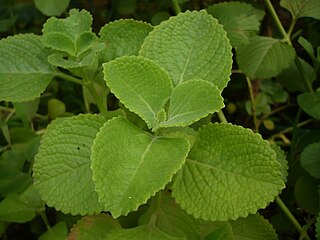
Coleus amboinicus, synonym Plectranthus amboinicus, is a semi-succulent perennial plant in the family Lamiaceae with a pungent oregano-like flavor and odor. Coleus amboinicus is considered to be native to parts of Africa, the Arabian Peninsula, and India, although it is widely cultivated and naturalized elsewhere in the tropics where it is used as a spice and ornamental plant. Common names in English include Indian borage, country borage, French thyme, Indian mint, Mexican mint, Cuban oregano, soup mint, Spanish thyme. The species epithet, amboinicus refers to Ambon Island, in Indonesia, where it was apparently encountered and described by João de Loureiro (1717–1791).

Mentha aquatica is a perennial flowering plant in the mint family Lamiaceae. It grows in moist places and is native to much of Europe, northwest Africa and southwest Asia.
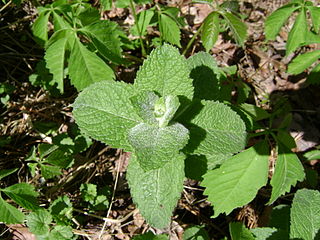
Mentha suaveolens, the apple mint, pineapple mint, woolly mint or round-leafed mint, is a member of the mint family Lamiaceae. It is native to southern and western Europe including the Mediterranean region. It is a herbaceous, upright perennial plant that is most commonly grown as a culinary herb or for ground cover.

Mentha longifolia, also known as horse mint, brookmint, fillymint or St. John's horsemint, is a species of plant in the family Lamiaceae. It is native to Europe excluding Britain and Ireland, western and central Asia, and northern and southern Africa.

Mentha arvensis, the corn mint, field mint, or wild mint, is a species of flowering plant in the mint family Lamiaceae. It has a circumboreal distribution, being native to the temperate regions of Europe and western and central Asia, east to the Himalaya and eastern Siberia, and North America. Mentha canadensis, the related species, is also included in Mentha arvensis by some authors as two varieties, M. arvensis var. glabrata Fernald and M. arvensis var. piperascens Malinv. ex L. H. Bailey.
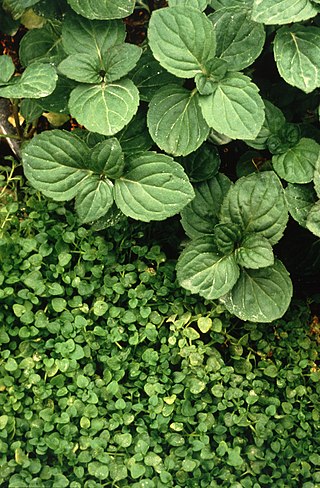
Richland is an unincorporated community and census-designated place (CDP) located within Buena Vista Township in Atlantic County, in the U.S. state of New Jersey. The area is served as United States Postal Service ZIP Code 08350.
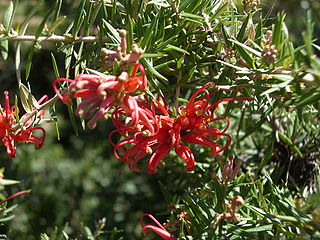
Grevillea juniperina, commonly known as juniper- or juniper-leaf grevillea or prickly spider-flower, is a plant of the family Proteaceae native to eastern New South Wales and southeastern Queensland in Australia. Scottish botanist Robert Brown described the species in 1810, and seven subspecies are recognised. One subspecies, G. j. juniperina, is restricted to Western Sydney and environs and is threatened by loss of habitat and housing development.

Mentha canadensis is a species of mint native to North America and the eastern part of Asia. In North America, it is commonly known as Canada mint, American wild mint, and in Asia as Chinese mint, Sakhalin mint, Japanese mint, and East Asian wild mint. The flowers are bluish or have a slight violet tint. The plant is upright, growing to about 4–18 in (10–46 cm) tall. Leaves grow opposite from each other, and flower bunches appear in the upper leaf axils. The mint grows in wet areas but not directly in water, so it will be found near sloughs, and lake and river edges. Plants bloom from July to August in their native habitats.
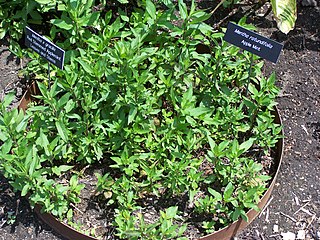
Mentha × gracilis is a hybrid mint species within the genus Mentha, a sterile hybrid between Mentha arvensis (cornmint) and Mentha spicata. It is cultivated for its essential oil, used to flavour spearmint chewing gum. It is known by the common names of gingermint, redmint and Scotchmint in Europe, and as Scotch spearmint in North America.

Monardella villosa is a plant in the mint family which is known by the common name coyote mint.

Mentha cervina, commonly known as hart's pennyroyal, is a perennial herbaceous plant of the Mentha (mint) genus. It is native to the western Mediterranean Sea region, growing naturally from southwestern France to the Iberian Peninsula, and south to Azores, Morocco and Algeria. Its common name reflects a traditional association with the separate species Mentha pulegium or pennyroyal. The plants were associated due to their shared high pulegone content, which gives them both a distinctive, strong aroma.

La Bodeguita del Medio is a restaurant-bar in Havana, Cuba. La Bodeguita lays claim to being the birthplace of the Mojito cocktail, prepared in the bar since its opening in 1942, although this is disputed. It has been patronized by Salvador Allende, the poet Pablo Neruda, the artist Josignacio and many others. The rooms are full of curious objects, frames, photos, as well as the walls covered by signatures of famous or unknown customers, recounting the island's past.

Yerba buena or hierba buena is the Spanish name for a number of aromatic plants, most of which belong to the mint family. Yerba buena translates as "good herb". The specific plant species regarded as yerba buena varies from region to region, depending on what grows wild in the surrounding landscape, or which species is customarily grown in local gardens. Perhaps the most common variation of this plant is spearmint. The term has been used to cover a number of aromatic true mints and mint relatives of the genera Clinopodium, Satureja or Micromeria. All plants so named are associated with medicinal properties, and some have culinary value as herbal teas or seasonings as well.
Apple mint is a common name for Mentha suaveolens, and hybrid mints involving M. suaveolens as a parent

Mentha gattefossei is a plant species in the genus Mentha, endemic to the Atlas Mountains of Morocco. It was first described by French botanist René Maire in 1922. Harvested for its essential oil, M. gattefossei has seen use in traditional medicine, pest control and as a food seasoning.



















